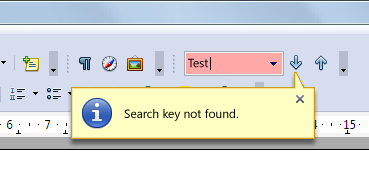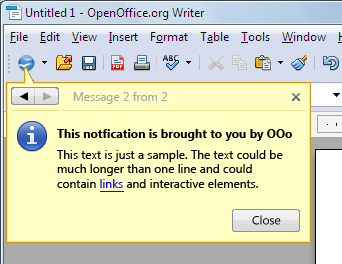Difference between revisions of "User Experience/Projects/NonModalMessageSystem"
| Line 1: | Line 1: | ||
{{User Experience}} | {{User Experience}} | ||
=Non Modal Message System= | =Non Modal Message System= | ||
| − | Current versions of OpenOffice.org use modal dialogs to give feedback in many situations. This interrupts users every time such a dialog is shown. Most of these | + | Current versions of OpenOffice.org use modal dialogs to give feedback in many situations. This interrupts users every time such a dialog is shown. Most of these messages are not that important, but it is no option to stop giving feedback. Furthermore new features, like sharing documents with others need a kind of message system to broadcast collaboration information. Giving feedback needs to be accessible, so it is not sufficient to show a message text somewhere in a dialog or just to change the color of a control. Those text and color changes will not be read by AT tools. |
Work in Progress. | Work in Progress. | ||
Revision as of 17:06, 18 November 2010
|
|
|---|
|
Quick Navigation Team Communication Activities |
Non Modal Message System
Current versions of OpenOffice.org use modal dialogs to give feedback in many situations. This interrupts users every time such a dialog is shown. Most of these messages are not that important, but it is no option to stop giving feedback. Furthermore new features, like sharing documents with others need a kind of message system to broadcast collaboration information. Giving feedback needs to be accessible, so it is not sufficient to show a message text somewhere in a dialog or just to change the color of a control. Those text and color changes will not be read by AT tools.
Work in Progress.
Message Types
Type 1
TBD: Show navigation on focus only.
Type 2
Temporary messages: Information is only of interest in a special context. I.e. feedback when searching the document.
Type 3
References
Christoph Noack
DirectManipulationSnippets Direct Manipulation Snippets
ContextualInformation



